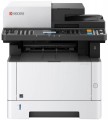Max resolution
The maximum resolution of the image to be printed. It is usually indicated by two numbers indicating the number of dots per inch (dpi) horizontally and vertically, for example 1200x600. The detail of the image depends on this parameter – the higher the resolution, the more fine details the printer is able to convey and the better their image will be. High print resolution is important, foremost, operating with graphic material; low resolution is sufficient for high-quality text display. So there are the following options:
600x600,
1200x600,
1200x1200,
1800x600,
2400x600,
2400x1200,
2400x2400,
4800x600,
4800x1200,
4800x2400,
5760, and
higher print resolutions.
First page print
The time passed from pressing the Copy button to the completion of the first copy in MFPs. Typically specified for low quality black and white printing on A4 paper. The time for the first copy to be released is the longest (because of the time to prepare for work and scan the document); subsequent copies of the same document are printed much faster.
Fast first copy time is important if you have to copy documents frequently.
B/W copy
Black and white copy speed – the number of copies of one page that the MFP can produce in 1 minute. Typically indicated for poor print quality. This option is important if you often need to make many copies of a single document.
B/W printing
The number of pages the printer can produce per minute in black and white mode. Typically indicated for low print quality, higher print quality takes longer. This setting is important if you need to frequently print text documents.
Autofeed
The maximum amount of sheets that can be loaded into the MFP's document autofeed at one time.
The autofeed makes it easy to scan and copy a large amount of documents - just load a stack of sheets and turn on the programme, after which each document will be automatically fed for scanning. An auto-feed MFP is worth considering if you frequently scan or copy a large amount of documents.
Black Ink Page Yield
Approximate number of pages that the MFP can print in black and white mode without replacing the cartridge. In fact, this greatly depends on the specs of the images to print, so the actual resource may greatly differ from the claimed one in one way or another. Nevertheless, according to this indicator, it is quite possible to evaluate the capabilities of the MFP and compare it with other models.
Cartridge model
Types of cartridges (both black&white and colour) used in the MFP. Some models of the MFP are able to work with third-party cartridges, but this feature usually refers to undocumented, and the manufacturer's warranty applies only to specific types of cartridges. So, use third-party compatible cartridge models with caution.
Display
The type of display provided in the design of the MFP. This parameter is indicated by two points — colour (monochrome or
colour display), as well as the availability of a
touch screen(if only spec 'coloured' is indicated, then the display is non-touch).
Chroma determines the features of the image on the display. Monochrome (black and white) displays allow you to show a lot of different information, and are inexpensive. On the other hand, such a display is poorly suited for viewing drawings and photos sent for printing, the results of scanning pictures, etc. — for such purposes it is better to use more expensive, but more functional colour displays.
As for touch displays, they provide additional convenience in management and expand its capabilities. Various controls can be displayed on such a display — sliders, lists, text menus, etc.; operating them with touches on the display is easier than using traditional control panels with hardware buttons. On the other hand, the presence of a sensor affects the cost of the display, and it makes sense to use this feature mainly in advanced MFPs with an abundance of additional functions.
Diagonal
The diagonal of the display installed in the MFP.
The larger the display, the more convenient it is to use, the better you can see the image on it.
MFPs with a large display(from 7" and above) are especially convenient when you need to view various graphic materials on the screen — for example, photos for printing or scanned results. In addition, a large diagonal is highly desirable for touch screens (see "Display "). On the other hand, the larger the display, the more expensive it is and the more space it takes up, despite the fact that a small diagonal is enough for basic tasks and settings (this is already better than
models without a display). Therefore, even in the most advanced models this indicator does not exceed 10.4", and in general, large screens are typical mainly for high-end MFPs with an abundance of additional features.

